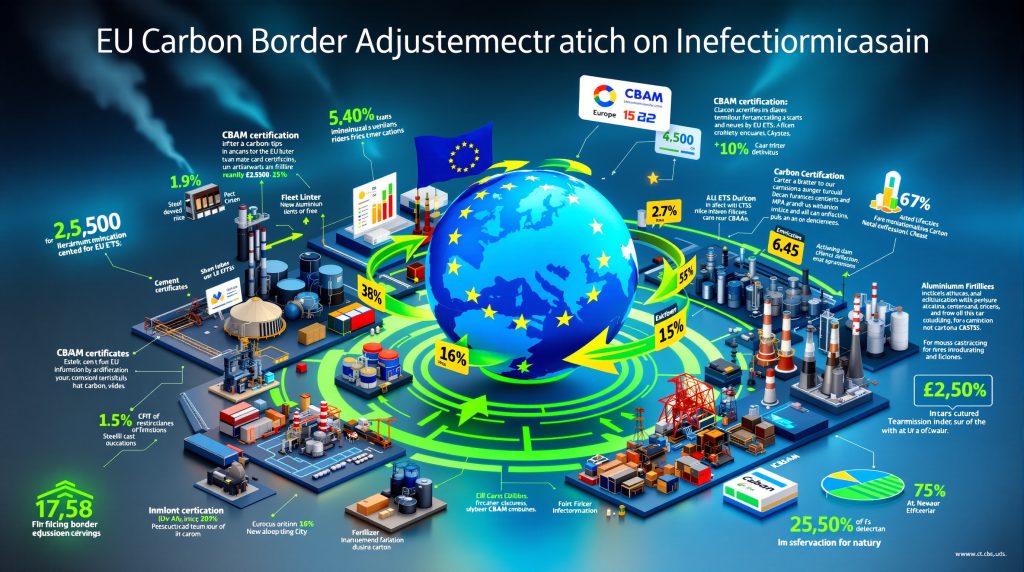Understanding the EU Carbon Border Adjustment Mechanism: A Comprehensive Guide to the Rules and Implementation
The EU Carbon Border Adjustment Mechanism represents a groundbreaking climate policy designed to prevent carbon leakage while encouraging global decarbonization. As the world's first carbon border tax, CBAM creates a level playing field between EU producers who pay for their carbon emissions under the EU Emissions Trading System (ETS) and foreign competitors who may not face similar environmental costs.
CBAM operates through a regulatory framework requiring importers to purchase certificates reflecting the carbon content of their imported goods. Unlike traditional tariffs, this mechanism focuses on environmental protection rather than economic protectionism, making it compatible with World Trade Organization rules.
How CBAM Aligns with EU Climate Goals
CBAM directly supports the EU's ambitious target of 55% greenhouse gas reduction by 2030 by addressing several key objectives:
- Prevents "carbon leakage" where production shifts to regions with less stringent climate policies
- Encourages global partners to implement their own carbon pricing mechanisms
- Protects EU industries from unfair competition while driving decarbonization
- Creates financial incentives for overseas producers to adopt cleaner production methods
Key Timeline for Implementation
| Phase | Period | Requirements | Financial Impact |
|---|---|---|---|
| Transitional | October 2023 – December 2025 | Quarterly reporting of embedded emissions | No financial obligations |
| Definitive | From January 1, 2026 | Full implementation with certificate surrender | Direct carbon cost on imports |
The transitional period currently underway allows businesses to adapt their systems and procedures before financial obligations begin. Importers must report emissions data quarterly, building capacity for the definitive phase starting January 2026. The latest energy transition insights suggest this phased approach is critical for ensuring market stability.
Which Industries and Products Fall Under CBAM Regulations?
The initial scope of CBAM covers carbon-intensive sectors most vulnerable to carbon leakage. The mechanism targets specific products rather than entire industries, focusing on goods with high emissions intensity and significant trade exposure.
Current Product Categories Subject to CBAM
- Iron and steel (including various forms and alloys, with stainless steel being a major concern for importers)
- Cement and cement clinker
- Aluminum (primary and processed)
- Fertilizers (nitrogen-based)
- Electricity generation
- Hydrogen production
Each category covers specific CN codes (Combined Nomenclature codes in the EU's classification system), with detailed product definitions in the regulation annexes. Recent industry evolution trends indicate these sectors are already adapting their operations in anticipation of the full implementation.
Emissions Scope and Boundaries
CBAM encompasses three types of emissions:
- Direct emissions: Greenhouse gases released during production processes (Scope 1)
- Indirect emissions: Emissions from electricity consumption during manufacturing (Scope 2)
- Embedded emissions: Total carbon footprint incorporated in imported goods
The EU Commission is currently finalizing methodologies for calculating each type of emission, with particular attention to electricity-related emissions given their variability across different power grids.
How Does the CBAM Certification Process Work?
Registration Requirements for Importers
Importers must register as "authorized CBAM declarants" through the EU CBAM Registry to legally import covered goods into the EU market. This registration process involves:
- Verification of business identity and legitimacy
- Designation of responsible representatives
- Establishment of reporting mechanisms
- Creation of CBAM certificate accounts
Without proper registration, importers will be unable to clear customs for CBAM-covered products starting in 2026.
Reporting Obligations During the Transitional Phase
During the current transitional phase (until December 2025), importers must submit quarterly reports containing:
- Total volume of imported goods by product category
- Actual embedded emissions (direct and indirect) in imported goods
- Carbon price paid in the country of origin (if applicable)
- Documentation supporting emissions calculations
These reports are building the foundation for the financial phase of the program while allowing authorities to refine implementation processes. For detailed information about the mechanism's functioning, the European Commission's CBAM overview provides official guidance.
Certificate Surrender Process Starting 2026
From January 2026, the financial obligations begin:
- Importers must purchase CBAM certificates corresponding to embedded emissions
- Certificate prices will mirror the weekly average auction price of EU ETS allowances
- Certificates must be surrendered annually by May 31 for the previous calendar year
- Adjustments apply for carbon prices already paid in countries of origin
Industry groups like EURANIMI have raised concerns about this timeline, noting that "contracts for next year are being signed now. Without clarity on benchmarks and verification rules, our members cannot calculate costs, negotiate prices or guarantee supply," according to their August 2025 statement.
What Are the Calculation Methodologies for Embedded Emissions?
The EU Commission launched a call for evidence in August 2025 specifically focused on calculation methodologies, seeking stakeholder input on three critical areas: direct embedded emissions, electricity emissions, and default values when actual data is unavailable.
Direct Emissions Calculation
For direct emissions embedded in imported goods, the approach will likely include:
- Product-specific emission factors
- Actual production data from manufacturing facilities
- Standardized calculation methodologies aligned with EU ETS monitoring
- Third-party verification requirements
The Commission is developing specific evidence requirements for third-party certification to ensure consistency and reliability.
Default Values When Actual Data is Unavailable
When importers cannot provide verified emissions data, default values will apply:
- Based on average emission intensity of each exporting country
- If country-specific data is unavailable, based on worst-performing 10% of EU producers
- Significantly higher than typical actual emissions to encourage proper reporting
This approach creates strong incentives for importers to obtain actual emissions data rather than relying on default values.
Electricity Emissions Considerations
Special methodologies apply for emissions from electricity consumption:
- Based on country-specific electricity emission factors
- Adjusted for renewable energy certificates where applicable
- Special provisions for countries with integrated electricity markets
The Commission is seeking input on how to fairly calculate electricity-related emissions while accounting for different power generation mixes globally.
How Will CBAM Certificates Be Priced and Adjusted?
Alignment with EU ETS Carbon Pricing
CBAM certificate prices directly reflect EU ETS allowance prices, creating parity between domestic and imported goods:
- Weekly average price of EU ETS allowances determines CBAM certificate cost
- Prices fluctuate based on market dynamics of the EU carbon market
- Expected to increase over time as EU ETS cap tightens
This direct linkage means importers will face the same carbon costs as EU producers, achieving the core objective of preventing carbon leakage. The OECD's analysis of CBAM effects provides additional context on the economic implications of this pricing mechanism.
Adjustments for Carbon Prices Paid in Exporting Countries
The EU Commission is developing rules for deducting carbon prices already paid in third countries:
- Explicit carbon taxes qualify for deduction
- Certain emissions trading systems may qualify if deemed equivalent
- Requires verifiable evidence of carbon price payment
- Currency conversion methodologies being established
As part of the August 2025 consultation, the Commission is developing methodologies for converting foreign currency carbon prices to euros and specifying evidence requirements for these deductions.
Free Allocation Transition Period
As EU ETS free allocations phase out, CBAM certificate requirements will increase proportionally:
- Initially, CBAM obligation reduced by percentage of free allowances to EU producers
- Complete phase-out of free allowances expected by 2034
- Gradual increase in CBAM certificate requirements during transition
The Commission is developing methodology for calculating embedded free allocation and developing CBAM benchmarks derived from EU ETS benchmarks to ensure proper adjustment during this transition period.
What Simplifications and Exemptions Apply to CBAM?
De Minimis Threshold for Small Importers
A provisional agreement reached in June 2025 established a de minimis threshold:
- Exempts importers with less than 50 tonnes of covered goods annually
- Expected to exempt approximately 90% of importers (primarily SMEs)
- Maintains environmental integrity as these represent minimal emissions
- Reduces administrative burden on smaller businesses
According to the EU announcement, "in most cases, the measure can be expected to exempt small and medium enterprises and individuals who import small or negligible amounts of goods covered by the regulation from CBAM obligations."
Industry Calls for Implementation Grace Period
European industry associations have requested additional implementation flexibility:
- EURANIMI has called for a six-month grace period before importers are required to surrender CBAM certificates
- Concerns center around lack of clarity on benchmarks and verification rules
- Companies report difficulty calculating CBAM costs for 2026 contracts
- Supply chain stability concerns, particularly for SMEs
EURANIMI argues that the new consultations launched by the EU Commission show that the EU is "not yet ready for January 2026 launch," and that uncertainty "threatens the stability of Europe's stainless steel supply chain, especially for SMEs."
International Trade Partner Considerations
The EU has signaled willingness to provide flexibility to international trading partners:
- An August 2025 US-EU Framework Agreement mentions "additional flexibilities"
- Potential for recognizing equivalent carbon pricing systems
- Ongoing diplomatic discussions with major trading partners
These flexibilities are part of the EU's wider effort toward CBAM simplification while maintaining the environmental integrity of the program. Recent trade war global impacts have further complicated these international negotiations.
What Compliance Challenges Do Importers Face?
Data Collection and Verification Hurdles
Importers report significant challenges in gathering necessary emissions data:
- Many non-EU suppliers lack experience with emissions monitoring
- Complex supply chains make data collection difficult
- Verification requirements add cost and complexity
- Limited guidance on acceptable calculation methodologies
The EU Commission's ongoing consultations seek to address these challenges, but importers remain concerned about implementation timelines.
Administrative and Technical Requirements
The technical implementation of CBAM presents operational challenges:
- New IT systems and reporting interfaces
- Staff training requirements
- Documentation and record-keeping burdens
- Coordination between customs procedures and CBAM compliance
As of September 2025, limited responses to the EU's call for evidence consultation (only two companies had responded) highlight the gap between regulatory development and business readiness.
Risk of Non-Compliance Penalties
Failure to comply with CBAM requirements carries significant consequences:
- Potential denial of import clearance
- Financial penalties for incorrect reporting or certificate shortfalls
- Reputational damage for non-compliant companies
- Potential legal actions for serious violations
Rather than seeking a postponement to the policy, which would require approval by both the European Parliament and Council and is "politically unrealistic at this stage," EURANIMI proposes transitional exemptions that would "provide vital breathing space for importers and customs authorities to adapt to the definitive rules." A comprehensive tariffs impact analysis shows how these compliance costs affect market dynamics.
How Might CBAM Evolve in the Future?
Potential Expansion to Additional Sectors
The EU Commission is considering expanding CBAM to cover:
- Downstream products derived from already-covered materials
- Additional carbon-intensive sectors like paper, glass, and chemicals
- Complex manufactured goods with significant embedded emissions
Any expansion would likely follow a similar phased approach, beginning with reporting requirements before financial obligations.
Anti-Circumvention Measures Under Development
Concerns about circumvention have prompted development of additional rules:
- Addressing resource shuffling (where low-carbon products are diverted to EU)
- Preventing transshipment through non-CBAM countries
- Monitoring for slight modifications to avoid CBAM classification
- Addressing concerns about scrap metal loopholes
In a recent interview, Jostein Røynesdal, vice president and head of EU public affairs at aluminium producer Norsk Hydro, noted that "scrap and downstream loopholes that could allow market participants to avoid making necessary payments under the EU's Carbon Border Adjustment Mechanism were a threat to the policy's decarbonization objectives."
International Policy Harmonization Efforts
The EU is actively engaging with international partners on carbon pricing alignment:
- Discussions with G7 and G20 countries about carbon pricing coordination
- Potential for mutual recognition of carbon pricing mechanisms
- Diplomatic efforts to encourage global adoption of similar measures
The August 2025 US-EU Framework Agreement demonstrates progress on international coordination, potentially establishing a model for engagement with other trading partners.
What Should Businesses Do to Prepare for Full CBAM Implementation?
Immediate Actions for Importers
Businesses importing CBAM-covered goods should take these steps now:
- Register as authorized CBAM declarants if not already done
- Establish systems for collecting emissions data from suppliers
- Begin engaging with third-party verifiers
- Develop internal procedures for CBAM compliance
Companies should not wait for final methodologies to begin preparation, as systems development and data collection will take significant time.
Strategic Supply Chain Considerations
Forward-thinking companies are evaluating strategic implications:
- Assessing carbon intensity of current suppliers
- Exploring alternative sourcing from lower-carbon producers
- Evaluating vertical integration options
- Considering reshoring production to the EU
These strategic decisions require careful financial modeling and risk assessment, particularly given the uncertainty around implementation details and potential mining environmental concerns.
Financial Planning for CBAM Costs
Financial preparation is essential for managing CBAM impacts:
- Modeling potential CBAM certificate costs under various scenarios
- Developing pricing strategies to address additional costs
- Exploring contractual mechanisms to share CBAM costs with suppliers
- Evaluating hedging strategies for carbon price volatility
Without proper financial planning, companies risk significant margin erosion or competitive disadvantages when the financial obligations begin in 2026.
Frequently Asked Questions About CBAM
How does CBAM differ from carbon tariffs?
CBAM is not technically a tariff but rather a regulatory mechanism requiring importers to purchase certificates reflecting the carbon content of goods. Unlike traditional tariffs, CBAM aims to equalize carbon costs rather than protect domestic industries for economic reasons.
Will CBAM violate WTO rules?
The EU has designed CBAM to be compatible with World Trade Organization rules by focusing on environmental protection rather than trade discrimination. The mechanism applies equally to all countries and provides adjustments for carbon prices already paid.
How will CBAM affect global supply chains?
CBAM will likely accelerate the decarbonization of global supply chains as manufacturers seek to reduce embedded emissions. It may also lead to some reshoring of production to the EU or shifting production to countries with strong climate policies.
What happens if a country implements its own carbon pricing?
If a country implements a carbon pricing system deemed equivalent to the EU ETS, importers can deduct the carbon price paid in that country from their CBAM obligations. This creates an incentive for global adoption of carbon pricing.
How can businesses minimize CBAM compliance costs?
Businesses can reduce CBAM costs by sourcing from suppliers with lower carbon intensity, investing in supply chain transparency, and developing robust emissions tracking systems. Early preparation and engagement with suppliers are critical for minimizing compliance burdens.
The Global Impact of EU CBAM
The EU Carbon Border Adjustment Mechanism represents a watershed moment in climate policy, extending carbon pricing beyond borders and creating powerful incentives for global decarbonization. While implementation challenges remain, CBAM signals the EU's commitment to addressing climate change while protecting its industries from unfair competition.
As the first major economy to implement a carbon border adjustment, the EU is setting a precedent that other regions may follow. The success of CBAM will depend on balancing environmental ambition with practical implementation, international diplomacy, and business adaptation.
For businesses operating in global markets, CBAM necessitates a fundamental rethinking of supply chains, manufacturing processes, and strategic planning. Those who adapt quickly to this new carbon-constrained reality will find themselves better positioned for long-term success in an increasingly carbon-conscious global economy.
Disclaimer: The implementation details of CBAM are still evolving as the EU refines methodologies and responds to stakeholder feedback. Companies should consult with regulatory specialists and monitor official EU communications for the most current guidance.
Want to Stay Ahead of Critical Market Developments Like CBAM?
Don't miss out on market-moving announcements that could impact your investments. Discovery Alert's proprietary Discovery IQ model delivers instant notifications on significant ASX developments, providing you with actionable insights before the broader market reacts. Visit https://discoveryalert.com.au/ today to start your 30-day free trial and gain a crucial market advantage.




